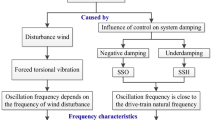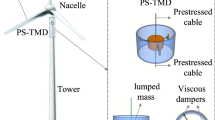Abstract
Torsional vibration is prevalent in rotating mechanical systems such as powertrain transmission. It is a hot spot in current torsional vibration control research to effectively suppress torsional vibration of the system by implementing adaptive torsional dampers with adjustable parameters. The current research focuses on the variable dam** torsional vibration absorber, while the investigation on variable stiffness torsional vibration absorber remains at the theoretical stage. With this premise, a transmission system with a novel magneto-rheological variable stiffness and dam** torsional vibration absorber (MR-VSDTVB) is proposed. MR-VSDTVB with sequential adjustment of torsional dam** and stiffness parameters is developed. Its aggregate dynamic output characteristics of stiffness and dam** are tested. To describe the nonlinear output characteristics with coupled multiple control parameters of MR-VSDTVB and the subsequent control, a GA-BP neural network model and a hierarchical inverse model are adopted. To validate the feasibility of the transmission system with MR-VSDTVB, a dynamic model of the transmission system with MR-VSDTVB is constructed and simplified, and then the numerical simulation analysis and experimental tests are carried out. The output performances of the MR semi-active system with various traditional semi-active control strategies show that the transmission system with the proposed MR-VSDTVB can suppress torsional vibration effectively.
Similar content being viewed by others
Abbreviations
- C d :
-
Dam** coefficient of the linear MR damper
- C s :
-
Dam** coefficient of the disc MR damper
- f 1 :
-
Coulomb friction of the disc MR damper
- C 1 :
-
Viscous dam** of the disc MR damper
- f 2 :
-
Coulomb friction of the linear MR damper
- C 2 :
-
Viscous dam** of the linear MR damper
- K d1, K d2 :
-
Stiffness coefficient of spring
- I c :
-
Current applied to the disc MR damper coil
- I d :
-
Current applied to the linear MR damper coil
- T e :
-
Excitation torque
- J i :
-
Moment of inertia
- K i :
-
Stiffness of the shaft
- T d :
-
Controllable torque
- T k, T c :
-
Controllable stiffness torque and dam** torque
- T max :
-
Maximum output torque of MR-VSDTVB
- T sky :
-
Output torque of skyhook controller
- T slid :
-
Output torque of sliding mode controller
- Θ 1 :
-
Deformation of the spring Kd1
- Θ 1, Θ 2 :
-
Angular displacement of the primary flywheel and secondary flywheel
- Θ 4 :
-
Angular displacement of the counterweight flywheel
- μ :
-
Switching parameter
- e :
-
Generalized error vector
- K s :
-
Structural stiffness coefficients of MR-VSDTVB
References
K. H. Lee, J. E. Park and Y. K. Kim, Design of a stiffness variable flexible coupling using magneto-rheological elastomer for torsional vibration reduction, Journal of Intelligent Material Systems and Structures, 30(15) (2019) 2212–2221.
N. S. Akbar, E. N. Maraj, N. F. M. Noor and M. B. Habib, Exact solutions of an unsteady thermal conductive pressure driven peristaltic transport with temperature-dependent nanofluid viscosity, Case Studies in Thermal Engineering, 35 (2022) 1–11.
J. Akram, N. S. Akbar, M. Alansari and D. Tripathi, Electroosmotically modulated peristaltic propulsion of TiO2/10W40 nanofluid in curved microchannel, International Communications in Heat and Mass Transfer, 136 (2022) 106208.
X. M. Dong, W. F. Li, J. Q. Yu, C. W. Pan, Y. Q. Zhou and X. H. Wang, Magneto-rheological variable stiffness and dam** torsional vibration control of powertrain system, Frontiers in Materials, 7 (2020) 1–16.
E. N. Maraj, N. S. Akbar, Z. Iqbal and E. Azhar, Framing the MHD mixed convective performance of cnts in rotating vertical channel inspired by thermal deposition: closed-form solutions, Journal of Molecular Liquids, 233 (2017) 334–343.
J. Akram, N. S. Akbar and D. Tripathi, Electroosmosis augmented MHD peristaltic transport of SWCNTs suspension in aqueous media, Journal of Thermal Analysis and Calorimetry, 147(3) (2022) 2509–2526.
M. G. Johann, P. Hermann and S. Karsten, Innovative torsional vibration reduction devices - vehicle-related design and component strength analysis, SAE International Journal of Passenger Cars-Mechanical Systems, 7(4) (2014) 1392–1403.
G. A. Pratt and M. M. Williamson, Series elastic actuators, International Conference on Intelligent Robotics and Systemes. IEEE Computer Society, Pittsburgh, PA, USA (1995) 399–406.
K. M. Xu and T. Igusa, Dynamic characteristics of multiple substructures with closely spaced frequencies, Earthquake Engineering & Structural Dynamics, 21 (1992) 1059–1070.
H. X. Sun, Y. F. Luo, X. Y. Wang and L. Zuo, Seismic control of a SDOF structure through electromagnetic resonant shunt tuned mass-damper-inerter and the exact H2 optimal solutions, Journal of Vibroengineering, 19(3) (2017) 2063–2079.
X. M. Dong, M. Yu, C. R. Liao and W. M. Chen, Comparative research on semi-active control strategies for magneto-rheological suspension, Nonlinear Dynamic, 59(3) (2010) 433–453.
J. E. Berno, M. K. Misgeld and L. Steffen, Multivariable friction compensation control for a variable stiffness actuator, Control Engineering Practice, 58 (2017) 298–306.
W. Hu, Y. L. Gao and B. T. Yang, Semi-active vibration control of two flexible plates using an innovative joint mechanism, Mechanical Systems and Signal Processing, 130 (2019) 565–584.
W. Hu, Y. L. Gao, X. Q. Sun, Y. K. Yang and B. T. Yang, Semi-active vibration control of a rotating flexible plate using stiffness and dam** actively tunable joint, Journal of Vibration and Control, 25(21–22) (2019) 2819–2833.
K. Williams, G. Chiu and R. Bernhard, Adaptive-passive absorbers using shape-memory alloys, Journal of Sound and Vibration, 249(5) (2002) 835–848.
N. S. Akbar, Z. Iqbal, B. Ahmad and E. N. Maraj, Mechanistic investigation for shape factors analysis of SiO2 = MoS2-ethylene glycol inside a vertical channel influenced by oscillatory temperature gradient, Canadian Journal of Physics, 97(9) (2019) 950–958.
M. B. Habib and N. S. Akbar, New trends of nanofluids to combat Staphylococcus aureus in clinical isolates, Journal of Thermal Analysis and Calorimetry, 143 (2021) 1893–1899.
J. Q. Yu, X. M. Dong, X. H. Wang, J. L. Li and B. Li, Design, modeling, and control of a magnetorheological rotary damper for scissor seat suspension, Proceedings of the Institution of Mechanical Engineers, Part D: Journal of Automobile Engineering, 234(9) (2020) 2402–2416.
G. L. Hu, L. F. Wu, L. S. Lin and L. F. Yu, Performance analysis of rotary magnetorheological brake with multiple fluid flow channels, IEEE Access, 8 (2020) 173323–173335.
X. M. Dong, C. Duan and J. Q. Yu, Axial squeeze strengthen effect on rotary magneto-rheological damper, Smart Materials and Structures, 26(5) (2017) 055022.
E. Abouobaia, R. Bhat and R. Sedaghati, Semi-active control of torsional vibrations using a new hybrid torsional damper, European Journal of Pharmacology, 19(2) (2013) 191–198.
L. B. Tian, S. B. Cai, G. J. Bao and Q. H. Yang, Design and kinematic modeling study of magnetorheological fluid flexure joints, Electrical and Mechanical Engineering, 34(5) (2017) 432–437.
E. N. Maraj, I. Zehra and N. S. Akbar, Rotatory flow of MHD (MoS2-SiO2)/H2O hybrid nanofluid in a vertical channel owing to velocity slip and thermal periodic conditions, Colloids and Surfaces A-Physicochemical and Engineering Aspects, 639 (2022) 128383.
X. M. Dong, J. **, P. G. Chen and W. F. Li, Magnetorheological variable inertia flywheel, Smart Materials and Structures, 27(11) (2018) 115015.
X. Deng, X. M. Dong, J. **, W. F. Li and J. **, A grey hysteresis model of magnetorheological damper, Journal of Intelligent Material Systems and Structures, 33(11) (2022) 1423–1438.
X. M. Dong, M. Yu, C. R. Liao and W. M. Ye, Comparative research on semi-active control strategies for magnetorheological suspension, Nonlinear Dynamics, 59 (2010) 433–453.
M. Ahmadian, A hybrid semi-active control for secondary suspension applications, ASME International Congress and Exposition, 11 (1997) 16–21.
C. N. Liu, L. Chen, X. F. Yang, X. L. Zhang and Y. Yang, General theory of skyhook control and its application to semi-active suspension control strategy design, IEEE Access, 7 (2019) 101552–101560.
M. F. Zhu, G. Lv, C. P. Zhang, J. M. Jiang and H. R. Wang, Delay-dependent sliding mode variable structure control of vehicle magneto-rheological semi-active suspension, IEEE Access, 10 (2022) 51128–51141.
O. Sahin, N. G. Adar, M. Kemerli, N. Caglar, I. Sahin, Z. Parlak, K. Kukrek and T. Engin, A comparative evaluation of semi-active control algorithms for real-time seismic protection of buildings via magnetorheological fluid dampers, Journal of Building Engineering, 42 (2021) 1–11.
Acknowledgments
The authors disclosed receipt of the following financial support for the research, authorship, and/or publication of this article: This work was financially supported by the Key Scientific Research Projects of Henan Higher Education Institutions (No.23B410004) and the National Natural Science Foundation of People’s Republic of China (Project NO. 52075056). These supports are gratefully acknowledged.
Author information
Authors and Affiliations
Corresponding author
Additional information
Wenfeng Li is a Lecturer at the School of Electrical and Mechanical Engineering, Xuchang University, China. He received his Ph.D. in Mechanical Engineering from Chongqing University in 2021, supervised by Professor **%20and%20variable%20stiffness%20torsional%20vibration%20control%20of%20powertrain%20transmission&author=Wenfeng%20Li%20et%20al&contentID=10.1007%2Fs12206-023-0705-1©right=The%20Korean%20Society%20of%20Mechanical%20Engineers%20and%20Springer-Verlag%20GmbH%20Germany%2C%20part%20of%20Springer%20Nature&publication=1738-494X&publicationDate=2023-08-02&publisherName=SpringerNature&orderBeanReset=true">Reprints and permissions
About this article
Cite this article
Li, W., Ge, X., Liang, M. et al. Magneto-rheological variable dam** and variable stiffness torsional vibration control of powertrain transmission. J Mech Sci Technol 37, 3887–3900 (2023). https://doi.org/10.1007/s12206-023-0705-1
Received:
Revised:
Accepted:
Published:
Issue Date:
DOI: https://doi.org/10.1007/s12206-023-0705-1




